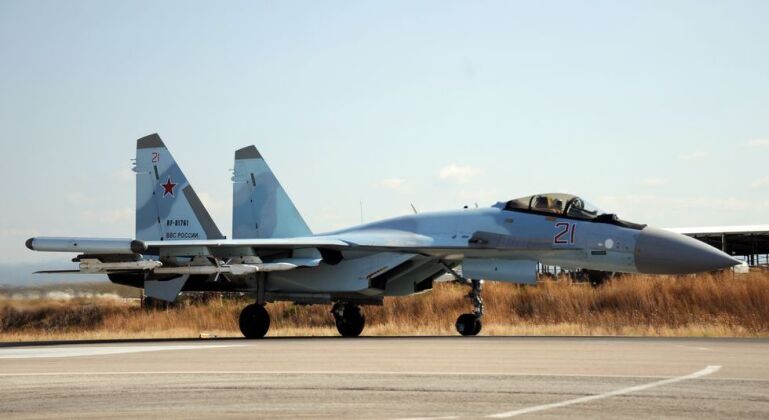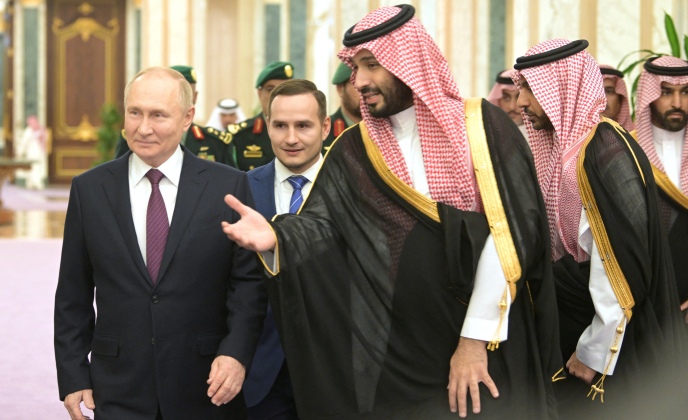News
Why Russian Su-35 Fighters Just Escorted Putin on Major Gulf Visit: Strategic Ties With Riyadh and Abu Dhabi in Spotlight

On December 6 the Russian Air Force deployed Su-35S fighters to escort President Vladimir Putin on a rare visit to the Persian Gulf Region, which marks his third trip outside the territory of the former Soviet Union since the escalation of war in Ukraine in February 2022 following visits to Beijing and Tehran earlier this year. The fighters were seen armed with R-77-1 and R-73 air to air missiles, and landed in the capital of the United Arab Emirates Abu Dhabi alongside the presidential Il-96 aircraft. Kremlin spokesman Dmitry Peskov stated following the escort mission: “During the flight of the presidential airplane to the landing in Abu Dhabi, the head of state was escorted by four Su-35S fighter jets of the Russian Aerospace Forces. These fighters carried standard armament of various classes. The Su-35S took off from an operational airfield in Russia in difficult weather conditions with heavy rain and gusty winds. The fighters were piloted by top-tier pilots.”
Regarding the purpose of deploying Su-35s, Peskov elaborated that while the UAE and Saudi Arabia are “stable, safe countries,” the surrounding neighbourhood “is certainly full of dangers and unpredictability, so, of course, all measures are being taken to ensure the security of the Russian head of state at the proper level.” A video of Su-35S fighter jets during the mission was released by the Russian Defence Ministry, showing an extreme contrast between the deep winter climates where they took off and the desert where then landed. The Su-35 has a comfortably longer range than any class of Western fighter, boasting more than double the range of the F-22 and F-35, which makes the aircraft ideal for such long ranged escort missions. The fighter class has gained a formidable combat record over Ukraine, and is very likely to have shot down more enemy fighters in air to air combat than any other 21st century fighter class. The aircraft are considered ‘4++ generation’ fighters, and lack key features seen on more modern fifth generation fighters such as active electronically scanned array radars and radar cross section reducing stealth airframes. Russia’s fifth generation fighter the Su-57 is close to ten years behind schedule in bring brought into service, meaning the Su-35 still forms the elite of the country’s fleet, although it has still seen more extensive combat usage than any other fighter of its generation due to its operations in Ukraine.

The deployment of Su-35s can be interpreted as a show of force particularly since a similarly small number of Su-35s played a major role in turning the tide of the Syrian War from the mid 2010s when the were deployed from a Russian airbase in the country. Su-35s based there on multiple occasions intercepted Israeli and Turkish F-16s to prevent them from carrying out attacks on Syrian targets. The fighters based in Syria have more recently in 2023 aggressively intercepted American MQ-9 Reaper drones which were illegally violating Syrian airspace, which in at least one incident seriously damaged the American aircraft. The Middle East is thus highly familiar with the fighter class’ capabilities. While the United Arab Emirates previously showed an interest in the Su-35, the country appears set to acquire more advanced fighters while the Su-35 itself is likely to form the backbone of the fleet of neighbouring Iran – which will receive its first squadron in 2024 and may subsequently place followup orders. With Western countries having long been the only foreign powers to deploy fighters to the Gulf the arrival of Su-35s, even very temporarily, has been taken as a signal of the growing shift in the region’s security dynamics. The fighters’ arrival follows multiple setbacks for Western security interests in the United Arab Emirates, including Abu Dhabi approving the opening of a security related facility associated with China’s armed forces, resisting of Western pressure to ban China’s Huawei from building new generation of telecommunications infrastructure, and acquiring its first Chinese fighter aircraft ordered in 2021.

In Abu Dhabi President Putin described the UAE as Russia’s “main trade partner in the Arab world,” highlighting the 67 percent increase in trade seen in 2022. The Arab state at the time played an important role in replacing Western imports after a breakdown in EU-Russian relations. Subsequently in Riyadh an agreement was signed for the further strengthening of defence cooperation, and the two states jointly urged further cuts to oil production by OPEC+ to reverse the trend towards diminishing prices. Gulf States have resisted significant Western pressure since early 2022 to distance themselves from Moscow and increase oil production to deny the country critical revenues, although such a policy shift never materialised. Russia began to strengthen ties with the Gulf in the late 2010s, when a cooling of relations between regional states and the Western world, and a major show of force by Moscow with its military intervention in Syria, between them created an opportunity for both sides to benefit from closer cooperation.












